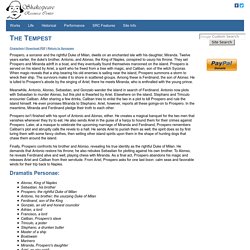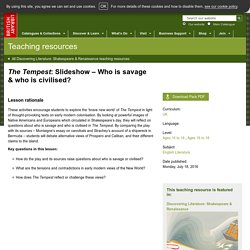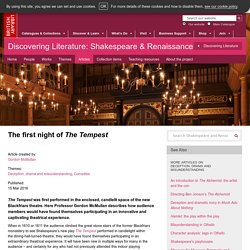

Shakespeare Learning Zone. Edu thetempest teacherpack 2016. Internet Shakespeare Editions. Production and rehearsal photos 2006. Act 1 Scene 2 Prospero Thy mother was a piece of virtue, and she said thou wast my daughter.

Prospero (Patrick Stewart) tells Miranda (Mariah Gale) about her background. Prospero Dost thou forget from what a torment I did free thee? Shakespeare Resource Center - The Tempest Synopsis. Characters | Download PDF | Return to Synopses Prospero, a sorcerer and the rightful Duke of Milan, dwells on an enchanted isle with his daughter, Miranda.

Twelve years earlier, the duke's brother, Antonio, and Alonso, the King of Naples, conspired to usurp his throne. The Tempest Plot Synopsis. The Tempest: Plot Summary Act 1, Scene 1 Act One opens amidst a great storm.

The Tempest. The Tempest. Shakespeare’s comedy about a major act of betrayal, ill treatment, the development of magic arts and a plot of revenge.

Twelve years ago, Prospero was Duke of Milan. Being of a bookish disposition, he withdrew more and more into his studies, leaving the management of his state to his brother Antonio. Eventually, with the help of Alonso, King of Naples, and the King's brother Sebastian - inveterate enemies of Prospero - Antonio usurped the dukedom for himself. Prospero and his baby daughter Miranda were put to sea in a rotten boat and eventually landed on a distant island once ruled by the witch Sycorax but now inhabited only by her son, Caliban, and Ariel, a spirit. Magic arts Since then Prospero has ruled the island and its two inhabitants by the use of magic arts derived from his studies. Revenge Prospero divines that fortune has brought his enemies close to the island and he sees an opportunity to work his revenge. The shipwrecked travellers are separated. Plots to kill. Plot summary - Revision 1 - KS3 English - BBC Bitesize.
Prospero: a Renaissance Magus. The Tempest: Who is savage and who is civilised? Lesson rationale These activities encourage students to explore the ‘brave new world’ of The Tempest in light of thought-provoking texts on early modern colonisation.

By looking at powerful images of Native Americans and Europeans which circulated in Shakespeare’s day, they will reflect on questions about who is savage and who is civilised in The Tempest. By comparing the play with its sources – Montaigne’s essay on cannibals and Strachey’s account of a shipwreck in Bermuda – students will debate alternative views of Prospero and Caliban, and their different claims to the island. Key questions in this lesson: How do the play and its sources raise questions about who is savage or civilised?
Post-colonial reading of The Tempest. Character analysis: Ariel and Prospero in The Tempest. Focussing on Act 1, Scene 2 of The Tempest, John Gordon analyses the characters of Ariel and Prospero through the frame of magic and power.

Key quotation Prospero Thou best know’st What torment I did find thee in; thy groans Did make wolves howl, and penetrate the breasts Of ever-angry bears. It was a torment To lay upon the damn’d, which Sycorax Could not again undo. It was mine art, When I arriv’d and heard thee, that made gape The pine, and let thee out.Ariel I thank thee, master. (1.2.286–293) Setting the scene Act 1, Scene 2 of The Tempest takes place on the island shortly after a violent storm shipwrecks the Duke of Milan’s vessel. Usage terms Donald Cooper / Photostage www.photostage.co.uk Miranda wonders if the storm was caused by her father’s ‘art’ (1.2.1), cueing his reassurance that he does ‘nothing but in care of thee’ (1.2.16) and that the crew of the ship are safe.
The first night of The Tempest. The Tempest was first performed in the enclosed, candlelit space of the new Blackfriars theatre.

Here Professor Gordon McMullan describes how audience members would have found themselves participating in an innovative and captivating theatrical experience. When in 1610 or 1611 the audience climbed the great stone stairs of the former Blackfriars monastery to see Shakespeare’s new play The Tempest performed in candlelight within the dining-hall-turned-theatre, they would have found themselves participating in an extraordinary theatrical experience. It will have been new in multiple ways for many in the audience – and certainly for any who had not previously attended this indoor playing space, newly reclaimed by the King’s Men to function as the winter counterpart to their long-standing open-air theatre, the Globe. The Tempest is a magical play, casting a spell over theatregoers and readers alike.
Black-Fryers. The Tempest and the literature of wonder. Martin Butler shows how Renaissance travel, trade and colonisation shaped the portrayal of Caliban and the Italians in The Tempest.

The Tempest is Shakespeare’s travel drama, a play responding to the enlarged geographical and mental horizons created by European exploration into distant places. It stages the disconcerting effects of surprise and estrangement provoked by the burgeoning literature of global discovery, with its reports of new and wonderful lands. Character analysis: Miranda in The Tempest. Lilla Grindlay explores the character of Miranda in Act 3, Scene 1 of The Tempest, considering language, form and a feminist interpretation.

Key quotation PROSPERO [aside] Fair encounter Of two most rare affections! (3.1.75) Setting the scene Act 3, Scene 1 takes us to the romantic heart of The Tempest; it is the scene where the play’s two young lovers, Ferdinand and Miranda, confess their love and vow to marry. Putting The Tempest in context: a summary of sources. Why should you read Shakespeare’s “The Tempest”? - Iseult Gillespie.